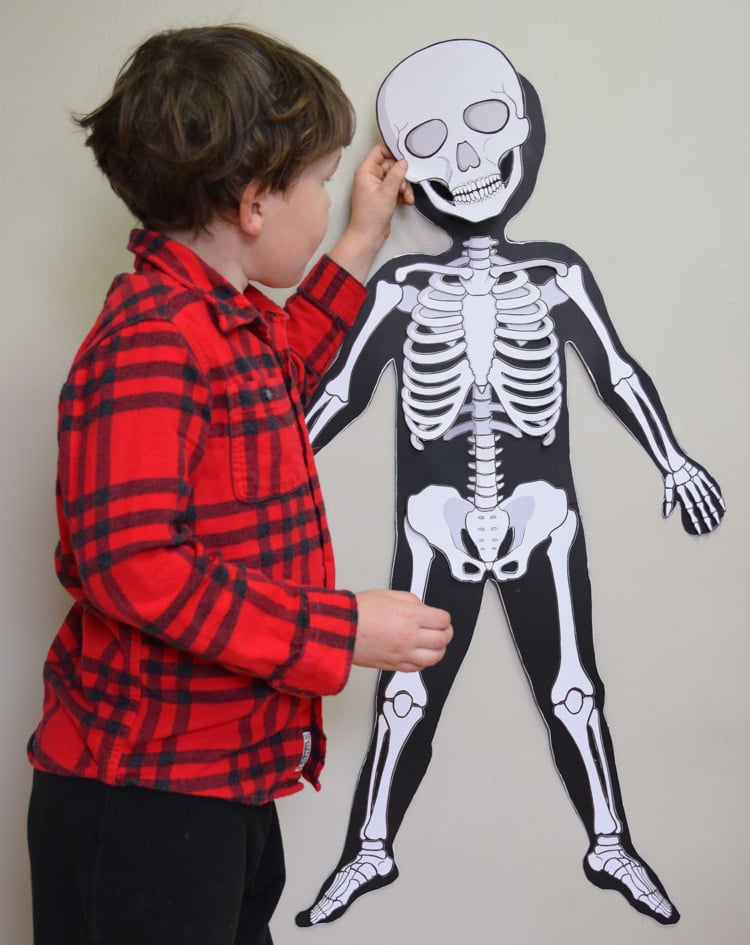

Skeletons are fascinating! Especially when you are seven or eight… First of all, kids at that age have some insatiable curiosity about how their bodies work, and if they can find information about this interesting subject presented in the right way, they’ll devour it with pleasure.
Second, skeletons in particular are a source of great interest in kids. At least, my son definitely thinks that they’re the most worthwhile of our body systems. They’re kind of spooky, just enough to spike his interest! But at the same time, they’re very real.
You see, as far as most of the other organs go, he has to believe they’re there (making the life-size human body model here helped!). But he can definitely feel the bones inside his body, which makes studying the skeleton a very personal experience.
Here is my son, hugging his printable skeleton buddy!

Do you know a kid who would also like a printable skeleton buddy? Or are you studying anatomy with kids? Making a printable human skeleton really helps them to connect the concept with themselves, and with the printable skeleton template that comes as a PDF file, building a life-size model for kids is a very quick project.
The printable human skeleton is scaled so that its size would be right for an average seven-year-old child. A few years older or a few years younger should be fine as well. If you have a child who is significantly smaller, print the pages at a reduced scale. When we were making an anatomy model of my two-year-old daughter, we printed the pages at an 80% scale.

All of the bones come in two versions. The first version has bone names written on them (cranium, mandible, humerus, etc), and the second version has no text. There is also a reference card that has keys to building a printable human skeleton and an information sheet that describes how our skeletal systems work.
If you want more information, take a look at our list of 10 best anatomy books for kids, where we have selected our favourites for different ages and levels of interest!

First, you’ll need a big sheet of paper (about 24″ x 52″). You can glue/tape two sheets of poster paper together or use the backside of wrapping paper. Brown kraft paper would also work! We chose black so that the bones would show up best.
Next, you’ll need to make an outline of the child’s body. On the picture below, my son (5) is finishing the outline of his sister’s (2) body. She loves feeling included and enjoyed making “paper Faye”!

If you also decide to use black paper, Sakura Gelly Roll white pens produce a nice bright line on black. I use them in a lot of my art projects.

Now, you can work with the outline on the floor and arrange all the bones without gluing them onto paper…

…or you can cut the outline out, attach it to the wall and assemble the printable skeleton with sticky tac or double-sided tape.
Here my son is finishing the printable skeleton of his little sister. I think he enjoyed working on a vertical surface more because it gave a certain anthropomorphic character to the paper model.

And here is his sister, next to the finished skeleton.

A few years passed, and she made her own printable skeleton too!

Moreover, when we studied anatomy with her, we created a life-size muscular system over her skeletal one. The two of them integrate together and showcase the interconnectivity of layers.

If you enjoyed the printable skeleton template, check out the Muscle Man as well!

And, of course, don’t forget the project that started it all – the printable life-size organs!

Want more anatomy activities? Try our bundles – Anatomy for Kids: Basic Systems and Anatomy for Kids: Advanced Systems. Following this hands-on anatomy unit study, children get to build life-size anatomy models of themselves, play with anatomy dress-up dolls, complete anatomy puzzles, build organs from play-dough, colour, draw and play games! The anatomy bundle is full of creative activities for young scientists.

When you make your own anatomy model, we’d be delighted to see it! Tag us on facebook or instagram (@adventureinabox).